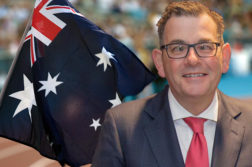The Victorian state election campaign is on in earnest.
With the poll scheduled for November 29, the Liberal-National government of Denis Napthine has already locked the filing cabinets and entered the caretaker period.
The election billboards are up, the radio and television ads are running, and the Coalition has already held its campaign launch in Ballarat.
Behind in the opinion polls and fighting to retain conservative government in the most left-leaning state in the Commonwealth, Napthine faces a stern challenge. An avuncular former vet from Portland in western Victoria, he is often derided as the ‘accidental premier’. But in a local party with little front bench talent, he may be the best thing the Coalition has going for it.
To see why Napthine faces such a tough re-election campaign, a little history is required.
Napthine took over from the hapless Ted Baillieu in 2010, after Baillieu failed to cope with the destabilising antics of controversial Frankston MP Geoff Shaw. Baillieu was no-one’s idea of an inspirational leader, but he didn’t have an easy time of things. The Coalition had won a narrow one-seat victory in 2010, surprising everyone by unseating Labor’s John Brumby – including, some say, Baillieu himself.
On gaining office, inertia set in. A series of surplus budgets were delivered, but Bailleu’s diffident presentation and the general air of languor that enveloped state politics led to charges of a “do nothing” government. Further, the ticking time bomb of Geoff Shaw made sure that the Coalition’s hold on government remained precarious. Shaw was engulfed in a string of scandals, eventually leaving the Liberal Party to sit on the cross-benches, where he continued to make life difficult for Baillieu and Napthine.
As a result, the Coalition has left many of its big policy moves until very late in the electoral cycle. The biggest was a decision to go ahead with the controversial East-West toll road, a giant highway that will dig up much of Melbourne’s inner north. At a cost of nearly $7 billion dollars, the government is spruiking the project as a traffic buster and job creator.
But there are signs that the East-West Link is not the vote winner the Napthine government thought it would be. The project is deeply unpopular in inner Melbourne, where it is opposed by several local councils that are directly affected. While more popular with motorists from the outer suburbs, who hope to enjoy a quicker commute, just how popular is difficult to determine. Opinion polls show voters prefer Labor’s policy of removing 50 level crossings around the city.
The policy rationale for the East-West Link is also rather threadbare. Promoted as a fix for traffic congestion, its dubious business case has never been fully revealed. Most experts think it won’t help traffic that much, especially when compared to a comparable investment in public transport. Worse, the contract for the tunnel and road is opaque, and the government has refused to reveal its full cost: while Victorian Treasurer Michael O’Brien says it will cost the state $6.8 billion, a group of Melbourne academics thinks it could cost as much as $18 billion, once the annual “availability” payments written into the contract are taken into account.
Perhaps this is why Napthine has pivoted towards public transport mid-way through the campaign. At the Coalition’s campaign launch in Ballarat, the central plank of Napthine’s speech was a $3.9 billion investment in new trains and trams. There was also a $100 handout for parents of children at kindergarten, and some ancillary goodies for regional infrastructure.
The trains and trams promise achieved its primary purpose of getting Napthine a splash in the media cycle, with some positive coverage in the newspapers and on local TV. But the more cynical pointed out that Ted Ballieu had also promised new trains and trams. Less than half the promised 40 trains have been delivered, with no new trams anywhere to be seen.
If Denis Napthine has a tough job to retain government, Labor’s challenge is preserving its current winning lead. Opposition Leader Daniel Andrews is in many ways similar to Napthine: unblessed with political charisma, his awkward presentation is only partially compensated for by a dogged work ethic.
The Coalition and its cheer-leaders at Murdoch tabloid, The Herald Sun, have tried to make Andrews a target during the campaign, playing up his links to the CFMEU construction union, and trying to link him to scandals from the Brumby years. It’s too early to tell whether this tactic is succeeding: voters are hardly surprised that a Labor leader has links to a trade union, and as yet there appears to be no real scandal or smoking gun.
For its part, Labor hasn’t tried to make this a beauty contest based on Andrews’ voter appeal, preferring instead to stick to its guns on a small set of well-tested policies.
Most importantly, Labor has signaled it will tear up the contracts for the East-West Link if it wins office, pledging to spend money on public transport instead. Whether Labor will actually do this is open to speculation: there are reportedly penalty clauses worth billions written into the fine print, and the East-West Link was formerly a Labor policy. But the ALP clearly believes the toll road is unpopular, and that it can win inner city votes by opposing it.
Speaking of the inner city, Labor has some intriguing contests on its hands against the Greens. In the café-dense hipster belt of inner Melbourne, a fierce battle is on for the progressive vote. While Labor has traditionally considered this safe territory, the Greens are mounting a significant grass-roots campaign this year, hoping to pick up lower house seats in electorates such as Melbourne, Richmond, Northcote and Brunswick. In the central seat of Melbourne, in particularly, Ellen Sandell looks a good bet to win.
The Greens insurgency is making Labor grumpy, forcing it to expend resources to defend seats that used to be ALP certainties. Andrews has publicly rejected a deal for Greens preferences, and also stated that he won’t deal with the Greens should he need their support to form a minority government. That’s a scenario that may haunt Labor in weeks to come.
On the other hand, the very fact that the Greens are polling in the high teens in inner Melbourne points to a central truth of politics in the Garden State: the remarkably progressive skew of the Victorian electorate.
Compared with their northern cousins, Victorians are roughly five points further left on most national opinion polls. There are a range of contributing factors explaining this this peculiar electoral geography: Melbourne’s proliferation of creative industries, for instance, with their attendant hipsters; the city’s multicultural composition; perhaps also Victoria’s history as a relatively well-educated and small-l liberal British colony.
Whatever the reasons, the result is a progressive slant to Victorian politics that would astonish Queenslanders and Western Australians. In the 2013 federal election, Labor actually won the two-party preferred vote in Victoria, polling 50.2 per cent. In Queensland, the ALP polled 43 per cent and in WA just 41.7 per cent.
This translates to a state election fought almost entirely on issues to the ALP’s liking, such as health, education and public transport. If Denis Napthine’s government wins, it will be campaigning on a platform that would seem almost socialist to many conservative northerners.
All of this means Labor is in the box seat, and needs only to defend its current lead to regain office. In contrast, Denis Napthine and the Coalition are playing catch-up. They need everything to go right between now and polling day to stay in the race.
That could still happen, of course. In 2010, Labor under John Brumby was leading in most polls well into the last week of the campaign – only to be blindsided by a swing that materialised on polling day.
Donate To New Matilda
New Matilda is a small, independent media outlet. We survive through reader contributions, and never losing a lawsuit. If you got something from this article, giving something back helps us to continue speaking truth to power. Every little bit counts.



